- Forum
- categories
- Sanitation systems
- Toilets with urine diversion
- UDDTs (urine-diverting dry toilets)
- Low-cost UDDTs in Adjumani, Northern Uganda - supported via surcharge on water bill
Low-cost UDDTs in Adjumani, Northern Uganda - supported via surcharge on water bill
6088 views
Dear all,
Let me take this opportunity to introduce Simon Icheanyi to you. He is the one who has been acting as private operator for the sludge treatment and the composting facilities in Adjumani. And he is also the one standing next to me in my profile photo.
Simon is an agronomist by training and a farmer and businessman by profession. He is operating the only cesspool emptying truck in Adjumani, and as such, he was almost predestinated to serve the municipality as a private operator of the two facilities. Most importantly, he is doing it out of real enthusiasm for the environment – a characteristic rarely seen in upcountry towns. He has really tried his best to operationalize these two facilities.
The problem has been a lack of real, practical support from the town administration, lack of maintenance of the access roads in particular (in spite of a contractual obligation to maintain the roads). Roads have been neglected to the point that the composting facility had to be closed down and that customers are staying away from the sludge treatment facility. The coordination with regard to the collection of market waste has also been poor.
That is not to say that individual officers in the administration are not environmentally minded. The Mayor, for example, is organizing ‘keep Adjumani clean’ events once in a month, and the Community Development Officer is also very enthusiastic about the environment (whose toilet is one of those depicted in the 2nd album). However, in practical terms, not enough has been done to support Simon with the two facilities.
On the other hand, interestingly, many officers of the town administration have been among those who have received support to construct an ecosan toilet. Even the Town Clerk is constructing (or has constructed) one, without the support, as he is stressing.
Kind regards, H-A
Let me take this opportunity to introduce Simon Icheanyi to you. He is the one who has been acting as private operator for the sludge treatment and the composting facilities in Adjumani. And he is also the one standing next to me in my profile photo.
Simon is an agronomist by training and a farmer and businessman by profession. He is operating the only cesspool emptying truck in Adjumani, and as such, he was almost predestinated to serve the municipality as a private operator of the two facilities. Most importantly, he is doing it out of real enthusiasm for the environment – a characteristic rarely seen in upcountry towns. He has really tried his best to operationalize these two facilities.
The problem has been a lack of real, practical support from the town administration, lack of maintenance of the access roads in particular (in spite of a contractual obligation to maintain the roads). Roads have been neglected to the point that the composting facility had to be closed down and that customers are staying away from the sludge treatment facility. The coordination with regard to the collection of market waste has also been poor.
That is not to say that individual officers in the administration are not environmentally minded. The Mayor, for example, is organizing ‘keep Adjumani clean’ events once in a month, and the Community Development Officer is also very enthusiastic about the environment (whose toilet is one of those depicted in the 2nd album). However, in practical terms, not enough has been done to support Simon with the two facilities.
On the other hand, interestingly, many officers of the town administration have been among those who have received support to construct an ecosan toilet. Even the Town Clerk is constructing (or has constructed) one, without the support, as he is stressing.
Kind regards, H-A
Hanns-Andre Pitot
M.Eng. Environmental Pollution Control
presently in Seesen, Germany
M.Eng. Environmental Pollution Control
presently in Seesen, Germany
The following user(s) like this post: Elisabeth
Please Log in to join the conversation.
You need to login to reply
Hi Krischan,
there are no analyses or studies as such, but it is obvious that there are only very few low income households that have had ecosan toilets constructed in Adjumani. These toilets are predominantly constructed by middle and high income people.
It is something that I have already pointed out on this forum. The investment cost of at least about 200 Euro is still too high for many households. I am adding the BOQ so that you can see the breakdown of the costs - add to the total of 588000 UGX in the BOQ about 90000 UGX for the materials provided by the Town Council.
In principle, small loans would be available for the construction of toilets, but I haven't heard of people utilizing them. May-be we didn't advertize that possibility strongly enough. But what I am now seeing changing, that is that an ecosan toilet can be a money maker. Certainly, the owner of the ecosan toilet with the tomato plantation documented in the 3rd album is making a lot of money with his toilet! Since almost everybody in Adjumani has a plot of land where crops are grown, this could become a catalyst to get a small loan and construct an ecosan toilet.
Greetings, H-A
there are no analyses or studies as such, but it is obvious that there are only very few low income households that have had ecosan toilets constructed in Adjumani. These toilets are predominantly constructed by middle and high income people.
It is something that I have already pointed out on this forum. The investment cost of at least about 200 Euro is still too high for many households. I am adding the BOQ so that you can see the breakdown of the costs - add to the total of 588000 UGX in the BOQ about 90000 UGX for the materials provided by the Town Council.
In principle, small loans would be available for the construction of toilets, but I haven't heard of people utilizing them. May-be we didn't advertize that possibility strongly enough. But what I am now seeing changing, that is that an ecosan toilet can be a money maker. Certainly, the owner of the ecosan toilet with the tomato plantation documented in the 3rd album is making a lot of money with his toilet! Since almost everybody in Adjumani has a plot of land where crops are grown, this could become a catalyst to get a small loan and construct an ecosan toilet.
Greetings, H-A
Hanns-Andre Pitot
M.Eng. Environmental Pollution Control
presently in Seesen, Germany
M.Eng. Environmental Pollution Control
presently in Seesen, Germany
This message has an attachment file.
Please log in or register to see it.
Please Log in to join the conversation.
You need to login to reply
Thanks for the updates!
Seem like the private replications spend considerable more on making them look nice outside? Is there any analysis on the socio-economic conditions in these replication households?
Seem like the private replications spend considerable more on making them look nice outside? Is there any analysis on the socio-economic conditions in these replication households?
Please Log in to join the conversation.
You need to login to replyRe: Low-cost UDDTs in Adjumani, Northern Uganda - supported via surcharge on water bill
Dear all,
I would like to let you know that I have updated the photo-documentation about the GIZ supported sanitation projects in Adjumani, Northern Uganda.* GIZ has recently performed an evaluation of the projects, and that has provided some interesting results. In more detail:
First album: www.flickr.com/photos/gtzecosan/sets/72157630727680876
The new photos show a new training of masons on UDDT construction, and the resulting 200 Euro ecosan toilet already mentioned on this forum. Also shown are pics of the five communal UDDT toilets GIZ has had constructed in Adjumani, and which have been accepted rather well:
www.flickr.com/photos/gtzecosan/15616783...et-72157630727680876
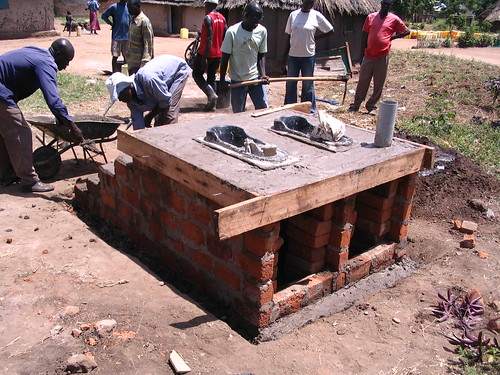
2nd training of masons by Sustainable sanitation , on Flickr
www.flickr.com/photos/gtzecosan/15429472...et-72157630727680876
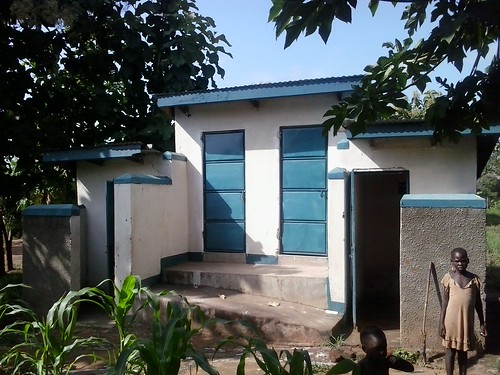
communal toilet by Sustainable sanitation , on Flickr
The album is also depicting some of the reason why the two facilities, composting and sludge treatment, have either failed or are still struggling: lack of maintenance of access roads, and lack of security on site.
Second album: www.flickr.com/photos/gtzecosan/sets/72157631160051774
The biggest surprise has been that, as of June 2014, around 100 (99) UDDT toilets had been constructed or were still under construction using private funds. Apart from private homes, one of the mosques, a health clinic, a primary school, etc. have had ecosan toilets constructed. I have added photos of the health clinic toilet and a detail from the mosque toilet.
Third album: www.flickr.com/photos/gtzecosan/sets/72157648589254468
This new album is showing how commercial growers are making use of the fertilizer products from UDDT toilets in Adjumani – or are lamenting that they cannot make use of it because the composting facility had to close down (until that road may be upgraded sometime) - another positive surprise during the evaluation:
www.flickr.com/photos/gtzecosan/15616172...et-72157648589254468
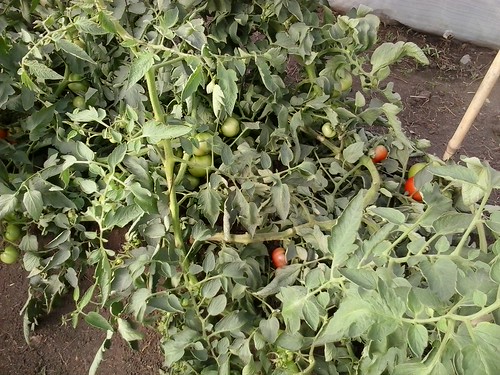
Commercial tomato growing: using ecosan products by Sustainable sanitation , on Flickr
www.flickr.com/photos/gtzecosan/15470416...et-72157648589254468
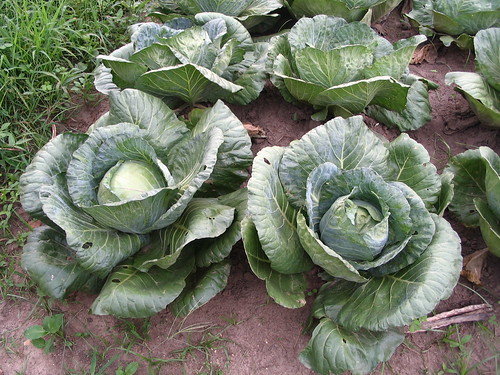
Cabbage fertilized with compost and urine by Sustainable sanitation , on Flickr
Hope you’ll enjoy the photos!
Regards to everybody,
H-A
* See related thread here: forum.susana.org/forum/categories/34-uri...charge-on-water-bill
(added by moderator)
I would like to let you know that I have updated the photo-documentation about the GIZ supported sanitation projects in Adjumani, Northern Uganda.* GIZ has recently performed an evaluation of the projects, and that has provided some interesting results. In more detail:
First album: www.flickr.com/photos/gtzecosan/sets/72157630727680876
The new photos show a new training of masons on UDDT construction, and the resulting 200 Euro ecosan toilet already mentioned on this forum. Also shown are pics of the five communal UDDT toilets GIZ has had constructed in Adjumani, and which have been accepted rather well:
www.flickr.com/photos/gtzecosan/15616783...et-72157630727680876

2nd training of masons by Sustainable sanitation , on Flickr
www.flickr.com/photos/gtzecosan/15429472...et-72157630727680876

communal toilet by Sustainable sanitation , on Flickr
The album is also depicting some of the reason why the two facilities, composting and sludge treatment, have either failed or are still struggling: lack of maintenance of access roads, and lack of security on site.
Second album: www.flickr.com/photos/gtzecosan/sets/72157631160051774
The biggest surprise has been that, as of June 2014, around 100 (99) UDDT toilets had been constructed or were still under construction using private funds. Apart from private homes, one of the mosques, a health clinic, a primary school, etc. have had ecosan toilets constructed. I have added photos of the health clinic toilet and a detail from the mosque toilet.
Third album: www.flickr.com/photos/gtzecosan/sets/72157648589254468
This new album is showing how commercial growers are making use of the fertilizer products from UDDT toilets in Adjumani – or are lamenting that they cannot make use of it because the composting facility had to close down (until that road may be upgraded sometime) - another positive surprise during the evaluation:
www.flickr.com/photos/gtzecosan/15616172...et-72157648589254468

Commercial tomato growing: using ecosan products by Sustainable sanitation , on Flickr
www.flickr.com/photos/gtzecosan/15470416...et-72157648589254468

Cabbage fertilized with compost and urine by Sustainable sanitation , on Flickr
Hope you’ll enjoy the photos!
Regards to everybody,
H-A
* See related thread here: forum.susana.org/forum/categories/34-uri...charge-on-water-bill
(added by moderator)
Hanns-Andre Pitot
M.Eng. Environmental Pollution Control
presently in Seesen, Germany
M.Eng. Environmental Pollution Control
presently in Seesen, Germany
The following user(s) like this post: JKMakowka
Please Log in to join the conversation.
You need to login to replyRe: Photos from Adjumani, Northern Uganda (low-cost UDDTs supported via surcharge on water bill)
Dear Phil, dear Canaday,
please excuse my late response! I have just been posted to Moroto in the Karamoja area of Uganda (which is known as something like the 'wild West' of the region), and Internet access has been difficult or non-existent.
About costs: Concerning one stand toilets for households, we have, in particular, investigated low cost alternatives. As of recent, we have tested some improvements in a training of masons, and I am attaching a view of that latest low cost toilet. It is similar to the older one, but we have been able to reduce costs to about 180 Euro overall. A bill of quantity was derived in the process, which I could send out to those who are interested. A regular toilet of the same design will, of course, cost a lot more, at least twice as much.
For school toilets, we have constructed a toilet with 5 stands and a wash room at 14 mil. UGX in 2009 (devide by about 3000 to get it in Euro). And the washer friendly 2 stand toilet with wetland treatment for the wash water has cost us 3.3 mil. UGX.
Concerning the instructions: The one you are mentioning, Canaday, has been drawn specifically for use at school by one of the pupils (and 'popped up' electronically). We have had bad experiences with school children adding ash themselves because they may misplace it into the urine side and cause cloggings which are very difficult or tidious to remove. So, we have the caretaker add the ash about twice a day after a visual assessment of what has been left behind. As far as I know, many other schools are following a similar approach. In the case of Adjumani, the school children who are allowed to use the ecosan toilet (the upper classes in a primary school) are willingly bringing the ash from home. They are also asked to bring one roll of toilet paper at the beginning of each term, which is kept and handed out by the school.
Hope I have answered your questions, and please feel free to get back to me if something has remained unclear or you need more information.
And concerning the latest low cost toilet, I am planing to include more photos among the ones that are posted at the Flicker Sustainable Sanitation site.
please excuse my late response! I have just been posted to Moroto in the Karamoja area of Uganda (which is known as something like the 'wild West' of the region), and Internet access has been difficult or non-existent.
About costs: Concerning one stand toilets for households, we have, in particular, investigated low cost alternatives. As of recent, we have tested some improvements in a training of masons, and I am attaching a view of that latest low cost toilet. It is similar to the older one, but we have been able to reduce costs to about 180 Euro overall. A bill of quantity was derived in the process, which I could send out to those who are interested. A regular toilet of the same design will, of course, cost a lot more, at least twice as much.
For school toilets, we have constructed a toilet with 5 stands and a wash room at 14 mil. UGX in 2009 (devide by about 3000 to get it in Euro). And the washer friendly 2 stand toilet with wetland treatment for the wash water has cost us 3.3 mil. UGX.
Concerning the instructions: The one you are mentioning, Canaday, has been drawn specifically for use at school by one of the pupils (and 'popped up' electronically). We have had bad experiences with school children adding ash themselves because they may misplace it into the urine side and cause cloggings which are very difficult or tidious to remove. So, we have the caretaker add the ash about twice a day after a visual assessment of what has been left behind. As far as I know, many other schools are following a similar approach. In the case of Adjumani, the school children who are allowed to use the ecosan toilet (the upper classes in a primary school) are willingly bringing the ash from home. They are also asked to bring one roll of toilet paper at the beginning of each term, which is kept and handed out by the school.
Hope I have answered your questions, and please feel free to get back to me if something has remained unclear or you need more information.
And concerning the latest low cost toilet, I am planing to include more photos among the ones that are posted at the Flicker Sustainable Sanitation site.
Hanns-Andre Pitot
M.Eng. Environmental Pollution Control
presently in Seesen, Germany
M.Eng. Environmental Pollution Control
presently in Seesen, Germany
Attachments:
-
lowcost22_1_1.JPG (Filesize: 48KB)
Please Log in to join the conversation.
You need to login to replyRe: Photos from Adjumani, Northern Uganda (low-cost UDDTs supported via surcharge on water bill)
Dear Hanns-André,
Congratulations on this important work.
Why does the (very artistic) instruction sheet say that the users should not add ashes themselves (while we know this would be best for controlling smell and flies)? Is this because the ashes are scarce and tend to run out? If so, maybe a more abundant cover material could be used, such as dry soil (mixed with the available ashes).
As I have mentioned in the following links in this forum, I promote the recycling of cover material, after it has been treated (by time, heat, sun, etc.) to eliminate the pathogens. This recycling makes cover material plentiful, without the need to constantly transport things long distance to and fro, plus it reduces the amount of smell and flies.
forum.susana.org/forum/categories/34-uri...e-interview-on-uddts
forum.susana.org/forum/categories/34-uri...terial-in-uddts#2866
Best wishes,
Chris Canaday
Congratulations on this important work.
Why does the (very artistic) instruction sheet say that the users should not add ashes themselves (while we know this would be best for controlling smell and flies)? Is this because the ashes are scarce and tend to run out? If so, maybe a more abundant cover material could be used, such as dry soil (mixed with the available ashes).
As I have mentioned in the following links in this forum, I promote the recycling of cover material, after it has been treated (by time, heat, sun, etc.) to eliminate the pathogens. This recycling makes cover material plentiful, without the need to constantly transport things long distance to and fro, plus it reduces the amount of smell and flies.
forum.susana.org/forum/categories/34-uri...e-interview-on-uddts
forum.susana.org/forum/categories/34-uri...terial-in-uddts#2866
Best wishes,
Chris Canaday
Conservation Biologist and EcoSan Promoter
Omaere Ethnobotanical Park
Puyo, Pastaza, Ecuador, South America
inodoroseco.blogspot.com
Omaere Ethnobotanical Park
Puyo, Pastaza, Ecuador, South America
inodoroseco.blogspot.com
Please Log in to join the conversation.
You need to login to replyRe: Photos from Adjumani, Northern Uganda (low-cost UDDTs supported via surcharge on water bill)
How much does it cost?
I would be most interested to know the approximate cost for building such a toilet structure in Uganda, both the single one for household use, and the 2 or 4 stance version suitable for a school. (The reason for my interest: I have been asked to sponsor toilets for a school in Uganda, and wonder what the actual cost should be?)
I would be most interested to know the approximate cost for building such a toilet structure in Uganda, both the single one for household use, and the 2 or 4 stance version suitable for a school. (The reason for my interest: I have been asked to sponsor toilets for a school in Uganda, and wonder what the actual cost should be?)
Please Log in to join the conversation.
You need to login to replyRe: Photos from Adjumani, Northern Uganda (low-cost UDDTs supported via surcharge on water bill)
Ok great, I will send you a message once I know in more detail how my assignment will be organised in the first couple of weeks. Perfect would be of course if I could visit Adjumani, but I doubt that will be possible still in 2012.
Please Log in to join the conversation.
You need to login to replyRe: Photos from Adjumani, Northern Uganda (low-cost UDDTs supported via surcharge on water bill)
Dear JK,
as per our present planning, I should be stationed in Adjumani until the end of 2012, so that we could possibly meet at the end of this year either in Kampala or in Adjumani itself. I would be happy to take you or anybody else for a tour in Adjumani. I suggest you first contact me by e-mail at This email address is being protected from spambots. You need JavaScript enabled to view it..
Kind regards,
Hanns-Andre
as per our present planning, I should be stationed in Adjumani until the end of 2012, so that we could possibly meet at the end of this year either in Kampala or in Adjumani itself. I would be happy to take you or anybody else for a tour in Adjumani. I suggest you first contact me by e-mail at This email address is being protected from spambots. You need JavaScript enabled to view it..
Kind regards,
Hanns-Andre
Hanns-Andre Pitot
M.Eng. Environmental Pollution Control
presently in Seesen, Germany
M.Eng. Environmental Pollution Control
presently in Seesen, Germany
Please Log in to join the conversation.
You need to login to replyRe: Photos from Adjumani, Northern Uganda (low-cost UDDTs supported via surcharge on water bill)
Thanks for those interesting pictures Hanns-André.
I will be actually working with UWASNET in Uganda starting at the end of this year so I am naturally interested in eco-san projects in Uganda. Would it be possible to get into contact with you sometimes in November, or early next year to share some experiences you had with UDDT in Uganda?
I will be actually working with UWASNET in Uganda starting at the end of this year so I am naturally interested in eco-san projects in Uganda. Would it be possible to get into contact with you sometimes in November, or early next year to share some experiences you had with UDDT in Uganda?
Please Log in to join the conversation.
You need to login to replyLow-cost UDDTs in Adjumani, Northern Uganda - supported via surcharge on water bill
Dear all,
First, allow me to introduce myself. I am Hanns-André Pitot, since 2008 technical advisor in the fields of water and sanitation in Adjumani, Northern Uganda. I am working for GIZ (formerly DED) and advising the Town Council of Adjumani. I am an engineer for environmental pollution control with a M.Eng. degree from the United States, and (still) a national of Mauritius.
I have placed two sets of photos on the Flickr page of „Sustainable Sanitation“ depicting the sanitation work we have been doing in Adjumani:
www.flickr.com/photos/gtzecosan/sets/72157630727680876/
www.flickr.com/photos/gtzecosan/sets/72157631160051774/
The first set of photos deals with our (that is GIZ and the Adjumani Town Council) approach to sanitation and waste management during the last couple of years, the second set of photos shows ecosan toilets that have been constructed by private means - partly initiated by our work at the Town Council. The photos come with detailed explanations, so that I won’t give details here.
In Adjumani, we have been following a „two track approach“ to sanitation and solid waste. The first track addresses existing sanitation systems and consists of the disposal of sludge from latrines and septic tanks in a constructed wetland system. The second track comprises of the promotion of ecological sanitation (UDDTs and a new design of composting toilets), and of a small manually operated composting facility where both the solids from ecosan toilets and organic waste from the town area are processed. As a financing instrument, there is a surcharge on piped water that we are using to finance support for the construction of ecosan toilets (the ones shown in the 2nd set of photos) and the purchase of compost for city greening purposes from the facility.
In recent times, there has been a lot of talk of reinventing the toilet to suit the needs of the very poor in developing countries. Our low-cost model of a UDDT as depicted in the first set of photos is costing less than 2 US cents per day per person (assume a 10 year life span, 5% interest on capital, and five users). As it turns out in Adjumani, they are still too expensive to be constructed by the very poor. It’s predominantly more affluent people who have ecosan toilets constructed either for themselves or for apartment complexes. The 2nd set of photos is showing the ones that have been finalized.
In terms of future additions to the system, we are planning to construct more demonstration toilets, and five shared ecosan toilets for clusters of very poor residents. In addition, we are thinking of a small bore sewage system for the town center with low-cost wetland treatment and irrigation of the treated water.
If there are any questions about the photos, I would be happy to answer them.
Kind regards to everybody,
Hanns-André
P.S. As an eye catcher, see here one photo out of the set where the link is given above:
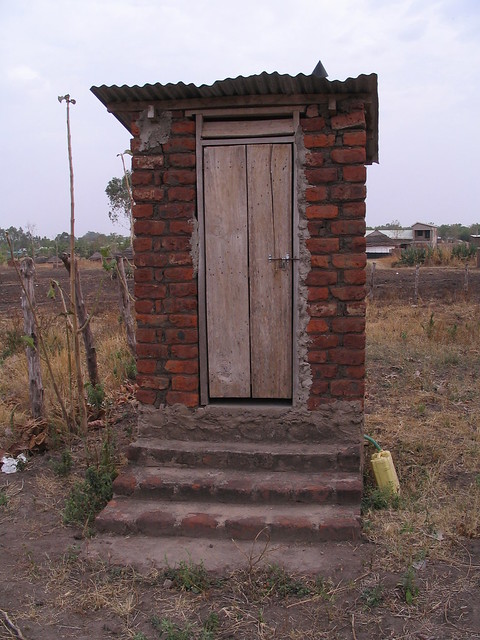
Low cost toilet by Sustainable sanitation , on Flickr
First, allow me to introduce myself. I am Hanns-André Pitot, since 2008 technical advisor in the fields of water and sanitation in Adjumani, Northern Uganda. I am working for GIZ (formerly DED) and advising the Town Council of Adjumani. I am an engineer for environmental pollution control with a M.Eng. degree from the United States, and (still) a national of Mauritius.
I have placed two sets of photos on the Flickr page of „Sustainable Sanitation“ depicting the sanitation work we have been doing in Adjumani:
www.flickr.com/photos/gtzecosan/sets/72157630727680876/
www.flickr.com/photos/gtzecosan/sets/72157631160051774/
The first set of photos deals with our (that is GIZ and the Adjumani Town Council) approach to sanitation and waste management during the last couple of years, the second set of photos shows ecosan toilets that have been constructed by private means - partly initiated by our work at the Town Council. The photos come with detailed explanations, so that I won’t give details here.
In Adjumani, we have been following a „two track approach“ to sanitation and solid waste. The first track addresses existing sanitation systems and consists of the disposal of sludge from latrines and septic tanks in a constructed wetland system. The second track comprises of the promotion of ecological sanitation (UDDTs and a new design of composting toilets), and of a small manually operated composting facility where both the solids from ecosan toilets and organic waste from the town area are processed. As a financing instrument, there is a surcharge on piped water that we are using to finance support for the construction of ecosan toilets (the ones shown in the 2nd set of photos) and the purchase of compost for city greening purposes from the facility.
In recent times, there has been a lot of talk of reinventing the toilet to suit the needs of the very poor in developing countries. Our low-cost model of a UDDT as depicted in the first set of photos is costing less than 2 US cents per day per person (assume a 10 year life span, 5% interest on capital, and five users). As it turns out in Adjumani, they are still too expensive to be constructed by the very poor. It’s predominantly more affluent people who have ecosan toilets constructed either for themselves or for apartment complexes. The 2nd set of photos is showing the ones that have been finalized.
In terms of future additions to the system, we are planning to construct more demonstration toilets, and five shared ecosan toilets for clusters of very poor residents. In addition, we are thinking of a small bore sewage system for the town center with low-cost wetland treatment and irrigation of the treated water.
If there are any questions about the photos, I would be happy to answer them.
Kind regards to everybody,
Hanns-André
P.S. As an eye catcher, see here one photo out of the set where the link is given above:

Low cost toilet by Sustainable sanitation , on Flickr
Hanns-Andre Pitot
M.Eng. Environmental Pollution Control
presently in Seesen, Germany
M.Eng. Environmental Pollution Control
presently in Seesen, Germany
The following user(s) like this post: tmsinnovation, JKMakowka
Please Log in to join the conversation.
You need to login to reply
Share this thread:
- Forum
- categories
- Sanitation systems
- Toilets with urine diversion
- UDDTs (urine-diverting dry toilets)
- Low-cost UDDTs in Adjumani, Northern Uganda - supported via surcharge on water bill
Time to create page: 0.109 seconds








